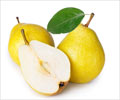At the University of Saskatchewan, researchers have discovered new potential in prairie fruits, in particular, buffaloberry, chokecherry and sea buckthorn.

"There is increasing interest in the commercial development of these fruits since historically it has been thought they may provide nutritional and health benefits," explained Dr. Rick Green, Vice President, Technology at POS Bio-Sciences in Saskatoon, co-author of the study. "Our results provide evidence that these fruits do, in fact, possess such nutritional benefits and contain compounds of interest for their health and wellness attributes. Thus, our work supports the commercial development of buffaloberry, chokecherry and sea buckthorn berries."
According to the study:
- Buffaloberry was high in ascorbic acid, at a level that was greater than 4 times that reported for oranges
- Chokecherry contained high levels of anthocyanin pigments (anti-oxidants) and can be considered a good source of these compounds with a concentration that was higher than the levels reported for fruits such as cranberry (anthocyanins purported health benefits include anti-inflammatory properties, and cardio-vascular benefits and potential anticarcinogenic properties)
- Sea buckthorn contained high levels of lipids for a fruit, though the level varies with location and variety.
- All of the fruits contained high levels of total dietary fibre
Potential uses for these native fruits are many. They can be used to produce nutrient-rich ingredients for at-risk Northern Saskatchewan, Canadian and global populations by blending fruits with Saskatchewan cereals and pulses. As ingredients, these materials can be used to improve the food value of traditionally prepared foods and as supplements for nutrient-poor populations. Or, simply, they can be consumed directly as a healthy snack.
"Funding for a major project to investigate and further develop these nutritive-rich ingredients is being sought from the recently established (2010) Global Institute for Food Security (GIFS)," says co-author of the study Dr. Nicholas Low, a Professor of Food Chemistry at the Department of Food and Bioproduct Sciences, University of Saskatchewan. GIFS is a public–private partnership that aims to address the growing global demands for safe and nutritious foods. In addition, future research areas may focus on the development of processed fruit products from these berries.
The article "Physicochemical composition of buffaloberry (Shepherdia argentea), chokecherry (Prunus virginiana) and sea buckthorn (Hippophae rhamnoides) fruit harvested in Saskatchewan, Canada" was published online today in the Canadian Journal of Plant Science.
Source-Eurekalert
 MEDINDIA
MEDINDIA




 Email
Email










